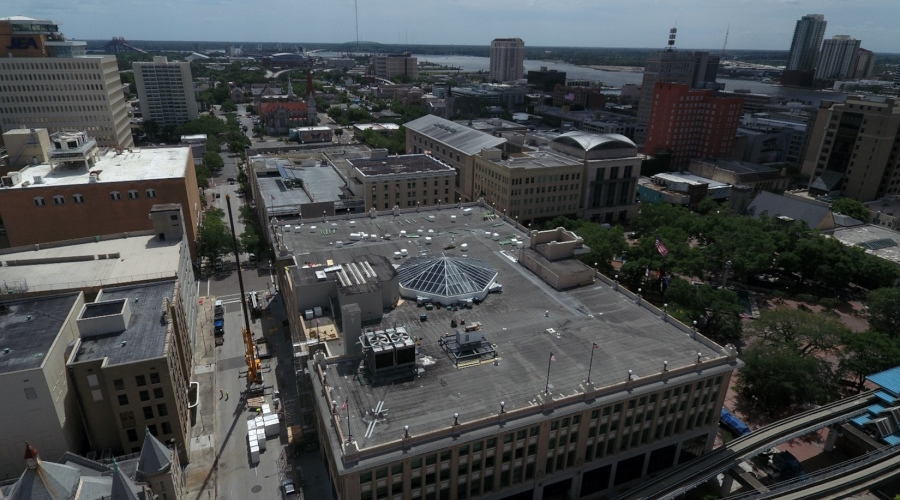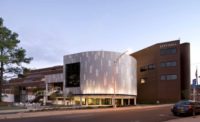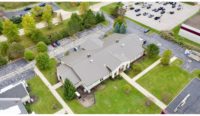Many roofing contractors will tell you that the easiest part of any project is the actual roofing work. This is particularly true of projects that have challenging administrative, safety, and/or installation requirements.
However, when it came to re-roofing the historic St. James Building in Jacksonville, Florida, which serves as City Hall, it was doubly challenging for McCurdy-Walden, Inc., a full-service commercial roofing and waterproofing contracting company based in the city. A variety of factors made this project especially challenging and complicated, including the building’s location and multiple roof levels, access to the roof, staging of the roofing materials, parking for the crew, coordinating the work with City Hall, as well as managing the intense safety and administrative requirements.
The building was designed by famed architect, John Klutho, and originally opened in 1912. In the late 1990s, the 342,000-square-foot facility underwent a complete renovation to bring the facility up to current standards and code requirements to restore many of the unique architectural details and match the original stone on the exterior façade. A key feature of the facility is its 75-foot octagonal glass dome mounted on the roof of the building’s fourth floor. Today, the building is registered in the National Register of Historic Places. It not only serves as Jacksonville’s City Hall; it also provides office and meeting space for many of Jacksonville’s Public Works Departments.
“Unfortunately, we were made aware of some of the more extensive administrative requirements for this project after we were awarded the contract and sitting at the pre-construction meeting,” said Jonathan Walden, Chief Operations Officer for McCurdy-Walden, Inc. “The administrative portion of the project turned out to be pretty challenging in itself. It involved city officials, their security team, a site-specific safety plan, hazard assessment report, evacuation procedures, rally points, and multiple points of egress, and all the men were trained on each procedure and knew what to do, where to go at any given point during the project.”
Safety First
Every one of McCurdy-Walden’s crew, as well as every subcontractor who went onto the roof, had to be fingerprinted and undergo a background check before they could access the facility or the roof. Once approved, each person was provided a badge for the project and still had to go through a security checkpoint to access the roof.
“We also had to provide the city’s security team with an updated employee list for daily sign in, and a weekly report of who accessed the project,” said Jaime Yanez, Project Superintendent for McCurdy-Walden.
To expedite daily access to the roof, McCurdy-Walden set up exterior stair scaffolding from the street level, which included a covered sidewalk area for foot traffic. The crews still had to check in with security, but access to the roof was faster and they didn’t have to walk through City Hall. “The scaffold was the best option for getting our workers on and off the roof quickly,” said Yanez. “But whenever anyone was on the scaffold, we were required to have a safety monitor on the ground for pedestrian safety.”
Another major hurdle for the project was the extensive site safety and evacuation plan. The roofing contractor had to develop an emergency evacuation plan with two egress routes, and meeting points from all sides of the building. “We have worked extensively with Jacksonville and other local cities, so we were familiar with some of the safety procedures, but the evacuation and emergency planning requirements for this project went way beyond anything we had done in the past,” said Walden.
If all of that was not challenging enough for McCurdy-Walden, the building consumes an entire block in the heart of the busy city, so loading and unloading the roof also posed challenges.
“We had to use a large 80-ton crane to get all the roofing materials and equipment to the roof,” said Yanez. “To do that, we started working at 3 am, and we shut down an entire street for the day. We had four police officers onsite that day redirecting foot and car traffic. Partway through the project, we had to load the roof with pallets of half-inch high-density cover board. The day before the work was to be done, everything was put on hold due to a last-minute City Council meeting. So, we had to scramble and reschedule the work for another day.”
The team also built a 12-inch-high, 16-foot by 16-foot platform on the roof to house a hydraulic hoist. The deck was necessary to provide extra clearance to lift materials up and over the 4-foot parapet wall.
“Our hoist does not have enough clearance for the parapet wall so we had to build a temporary deck on the roof,” said Yanez. “It was critical that we had the platform since we were constantly having to lift materials up and down from the street to the roof.”
Roofing Challenges
The 69,000-square-foot roof is divided into several sections and eight different levels, one of which was a mere 25 square feet. The building has a parapet wall, with a 5-foot ledge around the outside of the building. The old roof was a two-ply modified bitumen system with a cap over 2-inch wood fiber insulation. The roof was over 20 years old, blistering, and at the end of its useful service life. Most of the project was a recover however, McCurdy-Walden also had to remove and replace about 2,800 square feet of wet insulation with varying thicknesses and tear out and reinstall 8-foot by 8-foot sumps at every drain.
“Due to the building’s location and the size of the site, we could not have a trash chute from the roof or a permanent dumpster on site,” said Yanez. “So, we had to store the wet insulation and roofing materials on the roof until we could get a dumpster onsite for a short time. Then the crew would load the wet materials by hand into trash bags and then onto the hydraulic lift so they could be hoisted down to ground level and then hand-transferred again into a temporary dumpster onsite. That was another item that was not only time-consuming but also required strategic scheduling ahead of time and coordination with City Hall.”
The roof was originally specified as an 80-mil white PVC membrane, but McCurdy-Walden recommended Carlisle’s gray Sure-Flex PVC membrane with patented APEEL Protective Film for the project. “We felt that the gray material would be better than the white fora few reasons,” said Walden. “The glare from a white roof would be pretty bad for the surrounding buildings, so we suggested the gray, which we believe will not look as dirty over time. And we really love the way the APEEL product keeps the roof so clean during installation.”
Carlisle’s patented APEEL is a protective film on the surface of the membrane that protects it from scuffs and dirt accumulation during installation. The film is easy to remove, improves the aesthetics of the finished roof, and can save valuable time and labor by eliminating the need to clean the roof after the installation is completex. For a project as complex as City Hall,APEEL was the perfect addition.
"We’ve used the TPO APEEL product several times,” said Yanez,“but this was the first time we used the PVC APEEL product. We all really loved how easy it was to install and how great the roof looked at the end of the project.”
For the new roof, the crew from McCurdy-Walden first cleaned and vacuumed the roof to remove all the loose dirt and debris that had accumulated over the years. Then they fully adhered a 1/2-inch high density cover board over the existing modified bitumen roof using Carlisle’s VOC-free Flexible FAST Adhesive, a two component,low-rise polyurethane adhesive designed for bonding membrane or insulation to various substrates.“
Flexible FAST provides an additional R-value of 0.20 to 0.50per layer,” said Walden. “According to the National Roofing Contractor’s Association, up to 10% of R-value can be lost on the roof due to joints in the insulation, but the expanding nature of Flexible FAST Adhesive helps to seal insulation joints to maintain a consistent R-value, which is important here in Florida.”
On the wet areas of the roof, the crew completely removed the old roof and insulation down to the deck, which was part concreteand part steel. The deck was approximately 4.5 inches below the plane of the existing roof, so McCurdy-Walden installed two layersof 2-inch polyiso and the half-inch cover board to bring the roof to the proper height. The first layer of insulation was fully adhered to the concrete portion of the deck and mechanically fastened to thesteel section of the deck, with the second layer and cover board adhered over the top. Once that was finished, they fully adhered the 80-mil Carlisle Sure-Flex PVC membrane using Carlisle’s CAV-GRIP PVC Adhesive, an aerosol contact adhesive used to adhere the membrane to both horizontal and vertical services.
“CAV-GRIP is a real keeper for us, and we’ll never go back to bonding adhesives,” said Yanez. “Spraying the one-part adhesive is much faster in terms of set-up, and it flashes off very fast. By the time we finished spraying one roll, it was ready to be rolled in.The crew really liked working with the CAV-GRIP product, and we benefitted from the production rates.”
Multiple Levels & Mitered Corners
Another challenge was loading the roof. Due to space limitations in the dense city neighborhood, the crane could not reach all the various roofing sections and elevations, so McCurdy-Walden had to stage everything from the main roof level on the fourth floor of the building.“
Some of the roof elevations were 20 to 30 feet above the main roof, and one of them was only a 5-foot by 5-foot section,” said Yanez. “For those higher sections, we had workers on the lower level supporting the crew on the higher level by cutting the membrane and cover board and passing it up, as well as assisting with the adhesives, which was all very time consuming.”
In addition, the roof’s drainage which included internal drains,overflow drains, and through-wall scuppers needed to be addressed. The internal drains were cleaned, and new PVC-cladded roof drains were installed, bypassing the old assemblies.On the back side of the building, the crew also had to install sumps to improve drainage to the scuppers, which emptied into collector heads and downspouts on the outside of the building.
The overall roof design was complex. The entire roof has a low-slope from the front of the building to the back, for drainage to the through-wall scuppers. In addition, the roof slopes inward from the parapet wall from all four corners towards a series of internal drains located in a valley on three sides of the structure about halfway toward the center of the roof. The roof then slopes again inward toward the center and rear of the building for drainage to the scuppers. The membrane had to be mitered at a 45-degree angle from all the outside corners across the roof and valley, as well as down to the lower surface of the roof.
“We mitered the corners for aesthetic purposes and to be better looking from the surrounding buildings as well,” said Walden, “but it was time-consuming work. It really looks great and everyone from City Hall really liked the way it came out.”
There was also extensive flashing and detailing work on the roof. In addition to the numerous penetrations including vent pipes, exhaust fans, and a large chiller, there was a stairwell and several curbs to flash, and many new pitch pockets to install, not to mention the 75-foot octagonal dome on a 5-foot-tall stucco wall in the center of the building, which had to be re-flashed.
“The glass dome is an iconic centerpiece of the building’s design. It sits directly over the building’s central lobby,” said Yanez. “We had to remove all the glass panels, clean the glass and metal framework, including the horizontal structural joints, re-seal each panel, and ensure that weep holes were all open and functioning properly. Not only was it a ton of work, but whenever our team was working on the dome, we had to have the lobby closed to all foot traffic for safety. That was a big inconvenience for City Hall, and we had to push the dome work back several times to accommodate the City’s schedule. But in the end, our guys got it done and did it safely. It came out great.”
Then there was the electrical work. The St. James Building features a series of light posts on top of the perimeter wall every 20 feet around the front and sides of the building. Each light post sits on a 4-foot by 4-foot-wide base, and each has wiring that penetrates the roof behind the parapet wall that needed to be converted from a pitch pocket and flashed with a PVC Pipe Seal. Carlisle’s Certified Factory Approved accessories made this an easy job. There are also 10 larger posts supporting flag poles with lights mounted to the roof that illuminate the flags at night. This required the McCurdy-Walden crew to work closely with an electrical subcontractor for planning and scheduling. In addition, some 2,000 feet of aluminum cable, air terminals, and related connections for the building’s lightning protection system had to be removed at the outset of the project and then re-installed and re-certified at the end.
The last bit of roofing work was the 4-foot-wide perimeter outside of the parapet wall. For this portion of the roof, which was slightly sloped for drainage, the crew mechanically fastened the ½-inch cover board, and then fully adhered the membrane using CAV-GRIP. The membrane was then flashed to the side of the structure with a termination bar covered by surface-mount metal and terminated at the drip edge with Carlisle’s SecurEdge 2000 Extruded Drip Edge and SecurEdge 2000 Fascia system, which were also installed on top of the parapet wall and on the edges of all the higher portions of the roof.
“The crew were all in harnesses with lifelines secured around the 4-foot brick and concrete bases of the lamp posts,” said Yanez. “We had a few workers out on the ledge installing the roof, including a safety spotter, and then several others helping them from the roof side of the wall, providing materials and support. We also had a safety monitor on the sidewalk below whenever our crew was working on that part of the roof. We had to do this work over the weekend and during off hours when there was little or no traffic in the area. It was probably the most nerve-wracking portion of the project.”
The final work was to peel the APEEL Protective Film off the membrane. The film came off quickly and easily to reveal the very clean new roof.
In the end, the City of Jacksonville was very happy with the project. The APEEL kept the membrane looking clean and new, and everyone was very impressed with the magnitude of the challenging work by McCurdy-Walden.



